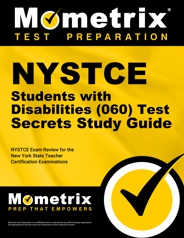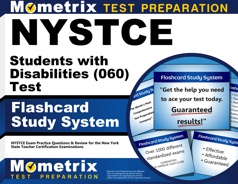The New York State Teacher Certification Exams program (NYSTCE) was designed for teachers in New York State to ensure proficiency in specific educational areas. The NYSTCE Students with Disabilities exam is designed for candidates entering the teaching field as a teacher of students with disabilities.
Click “Start Test” above to take a free NYSTCE Students with Disabilities practice test, and check out our premium-quality NYSTCE test prep resources by clicking the links below!
Exam Outline
The NYSTCE Students with Disabilities exam contains 90 selected-response questions and one constructed-response question, and you will be given a time limit of 3 hours and 15 minutes.
The exam is split into seven competencies.
1. Foundations of Special Education (11 questions)
The questions in this competency cover the following topics:
- The historical and philosophical foundations of the field of special education and of contemporary issues, trends, and research
- Relevant laws, regulations, state policies, and ethical guidelines
- The rights and responsibilities of students with disabilities, parents/guardians, teachers, other professionals, and schools
- Culturally responsive strategies that promote effective communication and partnerships with students with disabilities and their parents/guardians
- Effective strategies for communicating and collaborating with general education teachers, school staff members, paraprofessionals, related services providers, medical personnel, volunteers, and representatives of community agencies
- Strategies for engaging in self-reflection and ongoing professional development activities to enhance effectiveness as an educator of students with disabilities
- Strategies and information sources for remaining current regarding research-validated practice in the field of special education
- Local, state, and national services, resources, and organizations serving students with disabilities and providing program support
- The teacher’s responsibility to advocate for the interests of students with disabilities
2. Knowledge of Students with Disabilities (11 questions)
The questions in this competency cover the following topics:
- Typical and atypical human growth and development in various domains
- The characteristics, identification criteria, etiologies, and medical aspects of various types of disabilities
- Similarities and differences among students with and without disabilities
- How the characteristics of various disabilities can influence an individual’s education and life
- The different ways in which students with disabilities learn, including students from culturally and linguistically diverse backgrounds, and developmentally and age-appropriate strategies for addressing those differences
- Factors that affect development, learning, and daily living in students with disabilities
3. Assessment and Individual Living Program Planning (23 questions)
The questions in this competency cover the following topics:
- Basic and specialized terminology used in the assessment of students with disabilities
- The characteristics, uses, and limitations of various types of formal and informal assessments
- Strategies for selecting and administering nonbiased assessments for given students
- Interpreting information from formal and informal assessments
- How individual evaluation assessment and data and other assessment information is used to make eligibility, program, and placement decisions for students with disabilities
- Effective strategies for communicating assessment results to all stakeholders and strategies and procedures for creating and maintaining records
- Screening, prereferral (e.g., Response to Intervention), referral, and classification procedures
- The continuum of services and placements available for students with disabilities
- The components of IEPs and the roles and responsibilities of special education teachers in developing, implementing, monitoring, and modifying IEPs, transition plans, and behavioral intervention plans
- The roles of students with disabilities, parents/guardians, general education teachers, and related services providers in developing, implementing, monitoring, and modifying IEPs, transition plans, and behavioral intervention plans
4. Strategies for Planning and Managing the Learning Environment and for Providing Behavioral Interventions (11 questions)
The questions in this competency cover the following topics:
- How to create and maintain a safe, productive learning environment for all students, including establishing routines and appropriate physical arrangements
- Ways in which teacher attitudes and behaviors affect all students, strategies for establishing and maintaining rapport with all students, and strategies for adjusting communication in response to student needs
- Methods for ensuring individual academic success in one-to-one, small-group, and large-group settings
- Barriers to accessibility and acceptance of students with disabilities, adaptations that can be made to the learning environment to provide optimal learning opportunities for students with disabilities, and strategies for facilitating students’ active participation and fostering their independence
- Strategies for developing, implementing, monitoring, and modifying behavioral interventions for students with disabilities, including strategies for providing positive behavioral interventions and supports
- Appropriate strategies for crisis prevention and intervention
5. Instructional Planning and Delivery to Promote Students’ Success in the General Curriculum (23 questions)
The questions in this competency cover the following topics:
- Applicable local, state, and national curriculum standards, including the NYS P–12 Learning Standards, and how to align instruction for students with disabilities to these standards
- Co-planning and co-teaching methods to strengthen content acquisition of students with disabilities
- Research- or evidence-based practices that have been validated for learners with specific characteristics and for specific settings and knowledge of how to differentiate instruction by selecting, adapting, and using instructional strategies and materials according to the characteristics of a given student with disabilities
- Sources of specialized materials, curricula, and resources for students with disabilities
- Research- or evidence-based explicit and systematic instruction and intervention in reading for students with disabilities, including reading in the content areas
- Research- or evidence-based explicit and systematic instruction and intervention in writing for students with disabilities
- Research- or evidence-based explicit and systematic instruction in mathematics for students with disabilities
- Research- or evidence-based strategies for identifying and teaching essential concepts, vocabulary, and content across the general curriculum
- Research- or evidence-based methods for explicitly teaching learning strategies, listening skills, study skills, and test-taking skills to help students with disabilities acquire academic content; strategies for explicitly teaching students to use self-assessment, problem-solving, and other cognitive strategies to meet their own needs
- The use of technology for promoting academic success for students with disabilities
6. Strategies for Teaching Communication Skills, Social Skills, and Functional Living Skills (11 questions)
The questions in this competency cover the following topics:
- Instructional strategies for fostering communication skills of students with disabilities, including students from various cultural and linguistic backgrounds
- Knowledge of communication and social interaction alternatives for students with disabilities
- Strategies for integrating affective, social, career, and life skills with academic curricula
- Social skills needed for educational and other environments and strategies for designing, implementing, and evaluating instructional programs that enhance the social participation of students with disabilities across environments
- Strategies for teaching self-advocacy and self-determination skills and for encouraging increased independence
- How to plan and implement instruction in personal management skills, career development and occupational skills, and independent living skills, including instruction in community-based settings
- Strategies for promoting successful transitions between various environments during the school years
- Strategies for promoting successful post-secondary transitions
7. Analysis, Synthesis, and Application (1 question)
This competency contains the only constructed-response question, and it is the only question in the competency. You will be given an exhibit of information and be asked to write a 400-600-word response. You will be given instructions regarding the specifics of your written response.
Check Out Mometrix's NYSTCE Students with Disabilities Study Guide
Get practice questions, video tutorials, and detailed study lessons
Get Your Study Guide
Registration
To register for the NYSTCE Students with Disabilities exam, you will need to create an NYSTCE account online and complete the registration process there. It is recommended that you complete the registration process at least 30 days before you take the exam.
During this process, you will be asked some questions about your educational history, as well as your current education level, first language, matriculation status, and the education code for the NYC Department of Education program type you are associated with.
The examination fee is $122.
Test Day
You should arrive at the testing center 15-30 minutes earlier than the scheduled exam time to allow time for the check-in process. Once you arrive, you will be asked to sign in and provide a valid form of government-issued photo ID.
Before the exam begins, you will be asked to place all personal items (cell phone, wallet, keys, etc.) in a locker outside the testing room, or you may be asked to leave them in your car.
Once the test begins, you will be allowed to take breaks. However, the timer will not be stopped during your break, so use your break time carefully.
How the Exam is Scored
Your total score is based on the number of questions you answered correctly, which is then reported as a numerical figure in the range of 400-600. To pass the exam, you must achieve a scaled score of 520.
You should receive your test results roughly 2-4 weeks after taking the exam. When you receive your score report, you will see your total score, your pass/fail status, and your scores for each subarea of the test.
Check out Mometrix's Flashcards
Get complex subjects broken down into easily understandable concepts
Get Your Flashcards
FAQs
Q
How many questions are on the NYSTCE Students with Disabilities exam?
A
There are 90 selected response questions and one constructed-response question on the exam.
Q
How long is the NYSTCE Students with Disabilities exam?
A
The time limit for this exam is 3 hours and 15 minutes.
Q
What is the passing score for the NYSTCE Students with Disabilities exam?
A
To pass the exam, you must achieve a minimum scaled score of 520.
Q
How much does the NYSTCE Students with Disabilities exam cost?
A
The examination fee is $122.

